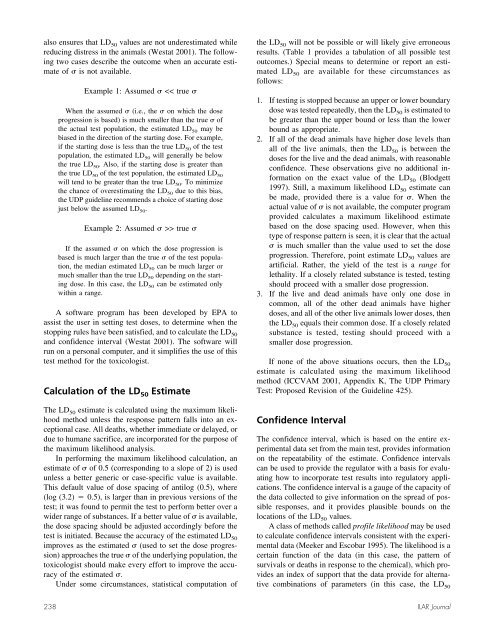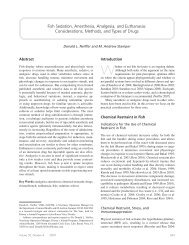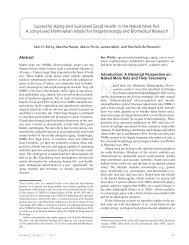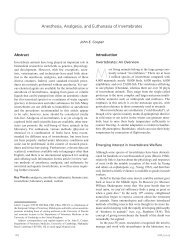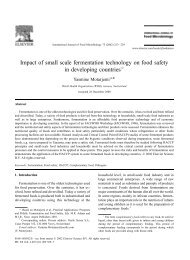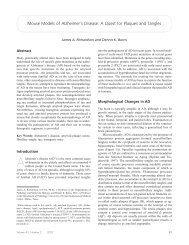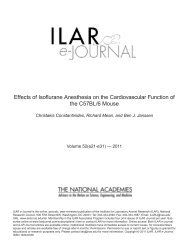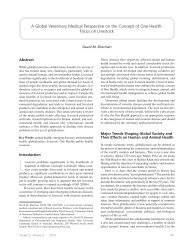Alternative Methods for the Median Lethal Dose (LD50) Test: The Up ...
Alternative Methods for the Median Lethal Dose (LD50) Test: The Up ...
Alternative Methods for the Median Lethal Dose (LD50) Test: The Up ...
You also want an ePaper? Increase the reach of your titles
YUMPU automatically turns print PDFs into web optimized ePapers that Google loves.
also ensures that LD 50 values are not underestimated while<br />
reducing distress in <strong>the</strong> animals (Westat 2001). <strong>The</strong> following<br />
two cases describe <strong>the</strong> outcome when an accurate estimate<br />
of is not available.<br />
Example 1: Assumed > true <br />
If <strong>the</strong> assumed on which <strong>the</strong> dose progression is<br />
based is much larger than <strong>the</strong> true of <strong>the</strong> test population,<br />
<strong>the</strong> median estimated LD 50 can be much larger or<br />
much smaller than <strong>the</strong> true LD 50 depending on <strong>the</strong> starting<br />
dose. In this case, <strong>the</strong> LD 50 can be estimated only<br />
within a range.<br />
A software program has been developed by EPA to<br />
assist <strong>the</strong> user in setting test doses, to determine when <strong>the</strong><br />
stopping rules have been satisfied, and to calculate <strong>the</strong> LD 50<br />
and confidence interval (Westat 2001). <strong>The</strong> software will<br />
run on a personal computer, and it simplifies <strong>the</strong> use of this<br />
test method <strong>for</strong> <strong>the</strong> toxicologist.<br />
Calculation of <strong>the</strong> LD 50 Estimate<br />
<strong>The</strong> LD 50 estimate is calculated using <strong>the</strong> maximum likelihood<br />
method unless <strong>the</strong> response pattern falls into an exceptional<br />
case. All deaths, whe<strong>the</strong>r immediate or delayed, or<br />
due to humane sacrifice, are incorporated <strong>for</strong> <strong>the</strong> purpose of<br />
<strong>the</strong> maximum likelihood analysis.<br />
In per<strong>for</strong>ming <strong>the</strong> maximum likelihood calculation, an<br />
estimate of of 0.5 (corresponding to a slope of 2) is used<br />
unless a better generic or case-specific value is available.<br />
This default value of dose spacing of antilog (0.5), where<br />
(log (3.2) 0.5), is larger than in previous versions of <strong>the</strong><br />
test; it was found to permit <strong>the</strong> test to per<strong>for</strong>m better over a<br />
wider range of substances. If a better value of is available,<br />
<strong>the</strong> dose spacing should be adjusted accordingly be<strong>for</strong>e <strong>the</strong><br />
test is initiated. Because <strong>the</strong> accuracy of <strong>the</strong> estimated LD 50<br />
improves as <strong>the</strong> estimated (used to set <strong>the</strong> dose progression)<br />
approaches <strong>the</strong> true of <strong>the</strong> underlying population, <strong>the</strong><br />
toxicologist should make every ef<strong>for</strong>t to improve <strong>the</strong> accuracy<br />
of <strong>the</strong> estimated .<br />
Under some circumstances, statistical computation of<br />
<strong>the</strong> LD 50 will not be possible or will likely give erroneous<br />
results. (Table 1 provides a tabulation of all possible test<br />
outcomes.) Special means to determine or report an estimated<br />
LD 50 are available <strong>for</strong> <strong>the</strong>se circumstances as<br />
follows:<br />
1. If testing is stopped because an upper or lower boundary<br />
dose was tested repeatedly, <strong>the</strong>n <strong>the</strong> LD 50 is estimated to<br />
be greater than <strong>the</strong> upper bound or less than <strong>the</strong> lower<br />
bound as appropriate.<br />
2. If all of <strong>the</strong> dead animals have higher dose levels than<br />
all of <strong>the</strong> live animals, <strong>the</strong>n <strong>the</strong> LD 50 is between <strong>the</strong><br />
doses <strong>for</strong> <strong>the</strong> live and <strong>the</strong> dead animals, with reasonable<br />
confidence. <strong>The</strong>se observations give no additional in<strong>for</strong>mation<br />
on <strong>the</strong> exact value of <strong>the</strong> LD 50 (Blodgett<br />
1997). Still, a maximum likelihood LD 50 estimate can<br />
be made, provided <strong>the</strong>re is a value <strong>for</strong> . When <strong>the</strong><br />
actual value of is not available, <strong>the</strong> computer program<br />
provided calculates a maximum likelihood estimate<br />
based on <strong>the</strong> dose spacing used. However, when this<br />
type of response pattern is seen, it is clear that <strong>the</strong> actual<br />
is much smaller than <strong>the</strong> value used to set <strong>the</strong> dose<br />
progression. <strong>The</strong>re<strong>for</strong>e, point estimate LD 50 values are<br />
artificial. Ra<strong>the</strong>r, <strong>the</strong> yield of <strong>the</strong> test is a range <strong>for</strong><br />
lethality. If a closely related substance is tested, testing<br />
should proceed with a smaller dose progression.<br />
3. If <strong>the</strong> live and dead animals have only one dose in<br />
common, all of <strong>the</strong> o<strong>the</strong>r dead animals have higher<br />
doses, and all of <strong>the</strong> o<strong>the</strong>r live animals lower doses, <strong>the</strong>n<br />
<strong>the</strong> LD 50 equals <strong>the</strong>ir common dose. If a closely related<br />
substance is tested, testing should proceed with a<br />
smaller dose progression.<br />
If none of <strong>the</strong> above situations occurs, <strong>the</strong>n <strong>the</strong> LD 50<br />
estimate is calculated using <strong>the</strong> maximum likelihood<br />
method (ICCVAM 2001, Appendix K, <strong>The</strong> UDP Primary<br />
<strong>Test</strong>: Proposed Revision of <strong>the</strong> Guideline 425).<br />
Confidence Interval<br />
<strong>The</strong> confidence interval, which is based on <strong>the</strong> entire experimental<br />
data set from <strong>the</strong> main test, provides in<strong>for</strong>mation<br />
on <strong>the</strong> repeatability of <strong>the</strong> estimate. Confidence intervals<br />
can be used to provide <strong>the</strong> regulator with a basis <strong>for</strong> evaluating<br />
how to incorporate test results into regulatory applications.<br />
<strong>The</strong> confidence interval is a gauge of <strong>the</strong> capacity of<br />
<strong>the</strong> data collected to give in<strong>for</strong>mation on <strong>the</strong> spread of possible<br />
responses, and it provides plausible bounds on <strong>the</strong><br />
locations of <strong>the</strong> LD 50 values.<br />
A class of methods called profile likelihood may be used<br />
to calculate confidence intervals consistent with <strong>the</strong> experimental<br />
data (Meeker and Escobar 1995). <strong>The</strong> likelihood is a<br />
certain function of <strong>the</strong> data (in this case, <strong>the</strong> pattern of<br />
survivals or deaths in response to <strong>the</strong> chemical), which provides<br />
an index of support that <strong>the</strong> data provide <strong>for</strong> alternative<br />
combinations of parameters (in this case, <strong>the</strong> LD 50<br />
238 ILAR Journal


